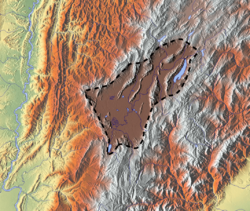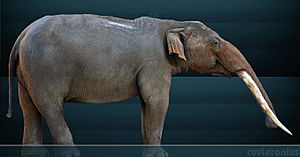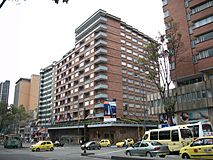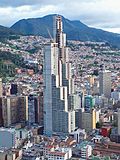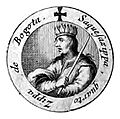Bacatá facts for kids
Quick facts for kids
Bacatá
Muyquytá / Muequetá (Chibcha)
|
|
|---|---|
|
Main seat of the zipa
|
|
| Etymology: literally "(enclosure) outside the farmfields" | |
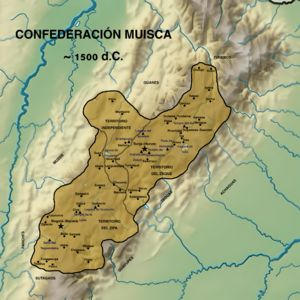
Map of the Muisca Confederation
|
|
| Country | Colombia |
| Department | Cundinamarca |
| Populated | Herrera Period |
| Founded by | Muisca |
| Elevation | 2,550 m (8,370 ft) |
| Geography | Bogotá savanna Altiplano Cundiboyacense Eastern Ranges Colombian Andes |
Bacatá (also called Muyquytá or Muequetá in the Chibcha language) was the main settlement of the Muisca Confederation. It was located on the Bogotá savanna in what is now Colombia. Bacatá was more of a large area than a single village. The modern town of Funza is in the center of this historical area.
Bacatá was the main home of the zipa. The zipa was the most important ruler of the Bogotá savanna and nearby lands. The name of Colombia's capital city, Bogotá, comes from Bacatá. However, the city of Bogotá was founded in a different spot, east of the Bogotá River.
The word Bacatá combines Chibcha words: bac, ca, and tá. It means "(enclosure) outside the farmfields." This name refers to the rich farmlands of the Bogotá savanna. Spanish conquerors led by Gonzalo Jiménez de Quesada took over Bacatá on April 20, 1537. The new capital, Santafe de Bogotá, was officially started on August 6, 1538.
The last zipa of independent Bacatá was Tisquesusa. He died after being attacked by a Spanish soldier. His brother, Sagipa, became the last zipa under Spanish rule. Today, the name Bacatá is used for Colombia's tallest skyscraper, BD Bacatá. It also names an important fossil found in the area, Etayoa bacatensis.
Contents
What Does Bacatá Mean?
The word Bacatá comes from the Chibcha language. This was the language of the native Muisca people. They lived in the Altiplano Cundiboyacense before the Spanish arrived.
The word is a mix of bac (or uac), ca, and tá. These mean "outside," "enclosure," and "farmfield(s)." So, Bacatá means "(enclosure) outside the farmfields." It can also mean "limit of the farmfields."
Today, you might see it spelled Muequetá and Muyquytá. In old Spanish writings, it was sometimes written as Bogothá.
Life Before the Spanish Arrived
The Altiplano Cundiboyacense is a high plateau in the Andes mountains of Colombia. It is about 2,600 meters (8,500 feet) above sea level. People have lived here for a very long time. The first signs of humans are from about 12,500 years ago. Early people lived in rock shelters like El Abra and Tibitó. Back then, giant animals like Cuvieronius roamed the land. These animals were hunted by the first humans.
As the climate got warmer, people moved from caves to open areas. They built simple round homes using bones and animal skins. Early open-air sites include Checua and Aguazuque.
The rich soil of the Bogotá savanna was great for farming. Farming was brought to the Muisca by people likely from Peru and Central America. The oldest signs of farming are from Zipacón, west of Bacatá, about 2,800 years ago. Around the same time, people started making pottery. This time is called the Herrera Period.
After 800 AD, the Muisca people developed more advanced ways of life. They improved farming and learned about the stars. Their society became more organized, and they had a rich religion and stories. The Muisca were known as great traders. They traded with other native groups.
A main part of their economy was salt. They got salt from mines in Zipaquirá and Nemocón. Muisca women were in charge of making salt. They heated salty water in pots over fires. This process gave the Muisca the nickname "The Salt People." High-quality salt was traded for other goods. It was also used to keep fish and meat fresh and to flavor their food. They also traded coca, gold, and emeralds.
The Muisca were skilled at working with gold. They made many golden figures called tunjos. These small figures were used in religious ceremonies. They were placed at sacred sites like lakes and wetlands. The Muisca believed these water bodies were gifts from their gods.
Lake Guatavita was a very important lake. It is a circular lake northeast of modern Guatavita. This lake is linked to the famous story of El Dorado. This means "the golden city or man." When a new zipa was chosen, he would cover himself in gold dust. Then, he would jump into the cold lake from a raft. This ceremony is shown in the famous Muisca raft artifact. You can see it at the Museo del Oro in Bogotá.
The flat lands of the Bogotá savanna had many small settlements. These had 10 to 100 bohíos (round houses). The Muisca built temples to honor their main gods. These included Sué (the Sun) and his wife Chía (the Moon). Another important god was Bochica. Muisca stories say he stopped the Bogotá River from flooding by creating the Tequendama Falls. The Bogotá River flows near Bacatá. People also built raised areas for farming near the river.
Muisca Confederation
The Muisca Confederation was a group of different Muisca leaders called caciques. They ruled small settlements on the Altiplano Cundiboyacense before the Spanish arrived. This area was about 25,000 square kilometers (9,650 square miles). It was divided into main areas, each with its own leader. The most important leaders were the zipa of Bacatá, the zaque of Hunza, the iraca of Suamox, and the leader of Tundama (near Duitama).
Spanish writers said that many smaller villages on the Bogotá savanna paid tribute to the zipa of Bacatá. Villages like Zipaquirá, Guatavita, and Suba were said to be under Bacatá's rule. However, some modern historians think the Spanish might have misunderstood. They believe the Muisca system was more about giving gifts than strict payments.
Today, experts like Jorge Gamboa Mendoza think the "confederation" was not as strict as the Aztec or Inca Empires. It was more likely a loose group of different Muisca communities. These communities had slightly different languages and customs.
Leaders of Muyquytá
| Zipa | Start | End | |
|---|---|---|---|
| Meicuchuca | ~1450 | 1470 | |
| Saguamanchica | 1470 | 1490 | |
| Nemequene | 1490 | 1514 | |
| Tisquesusa | 1514 | 1537 | |
| Sagipa | 1537 | 1539 |
The zipa was the leader of the southern Muisca lands, including the Bogotá savanna. We only know the names of the most recent zipas before the Spanish arrived. This is because the Muisca did not have a written language.
The first known zipa was Meicuchuca, who ruled Muyquytá from about 1450 to 1470. Many stories about him are myths. His nephew, Saguamanchica, became the next leader. Saguamanchica fought and defeated the neighboring Sutagao people in the Battle of Pasca. Later, Saguamanchica went to war with the zaque of Hunza, Michuá. Both leaders died in the Battle of Chocontá around 1490.
Nemequene followed Saguamanchica. Stories say he was a strict ruler. He created the Nemequene Code, a set of laws with harsh punishments. The salt mining village of Nemocón might be named after him. Nemequene died around 1514.
Tisquesusa became the psihipqua (leader) of Muyquytá after Nemequene. He was the ruler when the first Europeans arrived in March 1537. The Spanish conquerors came from the north. They had been on a difficult journey for almost a year. They brought horses, which the Muisca had never seen. The Muisca feared the horse riders, thinking the rider and horse were one creature. The Spanish also had hunting dogs that scared the Muisca people.
Spanish Conquest and New Rule
Tisquesusa, the zipa, heard a prophecy that he would "die, bathing in his own blood." When he learned the Spanish were coming, he left his main home in Muyquytá. The Spanish found the place empty. They then founded the village of Funza on April 20, 1537. This marked the end of the zipa's rule in Muyquytá.
Tisquesusa was injured by a Spanish soldier. He tried to escape into the hills west of the Bogotá savanna. As the prophecy said, he died alone in the hills of Facatativá. His body was found later.
After Tisquesusa, his brother Sagipa took over. This was unusual for the Muisca. Normally, the oldest son of the previous zipa's sister would become the new ruler. The Spanish used this to cause trouble for Sagipa. They also pressured him to give them valuable Muisca treasures.
The Spanish leaders used the Muisca's old enemies, the Panche people, to their advantage. The Panche lived on the western slopes of the mountains. The Spanish convinced Sagipa to fight alongside them against the Panche. This battle, the Battle of Tocarema, happened on August 19 and 20, 1537. Between 12,000 and 20,000 Muisca warriors, with a small number of Spanish soldiers, defeated the Panche.
The official founding of Santafe de Bogotá happened on August 6, 1538. This new city was near the Eastern Ranges. It became the capital of the New Kingdom of Granada. This ended Muyquytá's time as the main Muisca center.
Sagipa, no longer the main ruler, faced constant demands from the Spanish. They wanted Muisca treasures like gold, cotton clothes, and emeralds. In May 1539, Gonzalo Jiménez de Quesada left the New Kingdom of Granada. He left his younger brother, Hernán Pérez de Quesada, in charge. Hernán and other conquerors tried to force Sagipa to reveal where the treasures were. Sagipa did not survive this treatment. He died in the Spanish camp at Bosa in 1539. This ended the rule of the native Muisca on the Bogotá savanna.
The family line of Muyquytá continued through one of the first mixed-race marriages. Sagipa's daughter, Magdalena de Guatavita, married a Spanish conqueror. They had four children. Years later, one of their grandsons, Alonso Venegas, who was a descendant of Sagipa, was involved in a duel where he killed a Spanish official in 1566.
Things Named After Bacatá
- Hotel Bacatá: An old hotel in Bogotá's business center. It was replaced by the BD Bacatá skyscraper.
- BD Bacatá: The tallest skyscraper in Colombia.
- Etayoa bacatensis: A fossil of an ancient hoofed animal. It was found in the Bogotá Formation.
- Pegoscapus bacataensis: A type of fig wasp found only on the Bogotá savanna.
- Bacatá is also the name of a playable nation in the video game Europa Universalis IV.
- Bogotá and its related names come from Bacatá (or Muequetá, Muyquytá, Bogothá).
Images for kids
See also
 In Spanish: Bacatá para niños
In Spanish: Bacatá para niños


